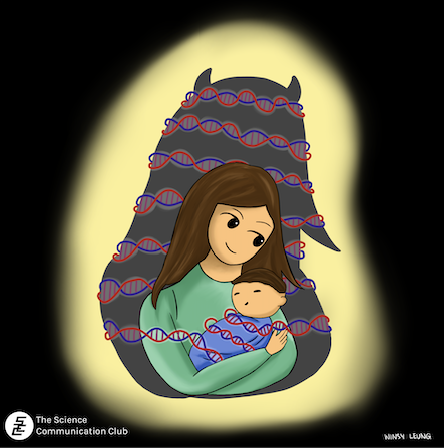
Written by Samuel Salamun
Illustrated by Winsy Leung
You might be familiar with the song “Mother Knows Best” from the Disney animation movie Tangled. This song was sung by Mother Gothel as she tried to keep Rapunzel trapped inside a tower by describing how dangerous the outside world is. However, later in the movie, it is revealed that mother Gothel had an ulterior motive undermining the saying that “Mother Knows Best”. But of course, real-life mothers wouldn’t do such things, right? Well, your mother might know best, but her mitochondria might not.
Mitochondria are important parts of our cells that provide us with ATP, the energy currency of the cell. In fact, they are often referred to as the “powerhouse of the cell!”. You might remember that mitochondria have their own set of DNA called mitochondrial DNA (or mtDNA). Unlike the DNA found in the nucleus of your cells (genomic DNA), mtDNA is only maternally inherited, which means that you get 100% of your mtDNA from your mother! Unfortunately, this mode of inheritance might result in a problem called the “Mother’s Curse”.
The Mother’s curse is an evolutionary theory that suggests the existence of genetic mutations that are harmful to males, but neutral or helpful to females. So how could maternal inheritance of mitochondria lead to the Mother’s curse phenomenon? Similar to genomic DNA, mtDNA acquires mutations here and there, and these might be transmitted to the next generation. Now, imagine that some of these mutations cause male sterility. From the mtDNA’s point of view, it does not matter since it is only passed down by females anyway. As long as the mutation does not prevent it from being inherited (for example, by causing female sterility), it couldn’t care less about what these mutations do! On the other hand, this is bad news for the male member of the species, since they receive these harmful mutant mtDNAs from their mothers and hence the “Mother’s Curse”.
As intriguing as this sounds, this theory had only been observed in plants until fairly recently. A study published in 2016 described the first evidence of the Mother’s Curse in animals, specifically in fruit flies. To study this theory, the researchers set up an experiment where flies were bred through 35 generations to promote the accumulation of mutations in mtDNA. At the end of this experiment, they assessed both male viability and fertility. While male viability was relatively unaffected, they found that male fertility was severely reduced! Interestingly, they did not observe a decline in female fertility, consistent with the “Mother’s Curse” theory. When they analyzed the mtDNA of the male flies, they found a mutation in a protein involved in the production of ATP called COII (subunit II of cytochrome C oxidase). Furthermore, they found that this mutation specifically impaired sperm development, resulting in male-only sterility. Interestingly, introducing this specific mutation to flies with different genomic DNA did not always result in male sterility, suggesting that there might be factors encoded by the genomic DNA that could suppress the effect of mtDNA mutations.
While this study was done in flies, the Mother’s Curse theory might have implications beyond just insects and plants. On average, 7-10% of men have a fertility defect, despite not having other medical conditions. Interestingly, mitochondria have been implicated in human male infertility. Thus, this study highlights the importance of basic science research and how it can help to build a foundation for future therapeutics.
Sources:
- Patel, Maulik R., et al. “A mitochondrial DNA hypomorph of cytochrome oxidase specifically impairs male fertility in Drosophila melanogaster.” Elife 5 (2016): e16923.
- Tompa, Rachel. “’Mother’s Curse’ mutation — harmful to males but not females — ID’d for the first time in animals.” Hutch News Stories.